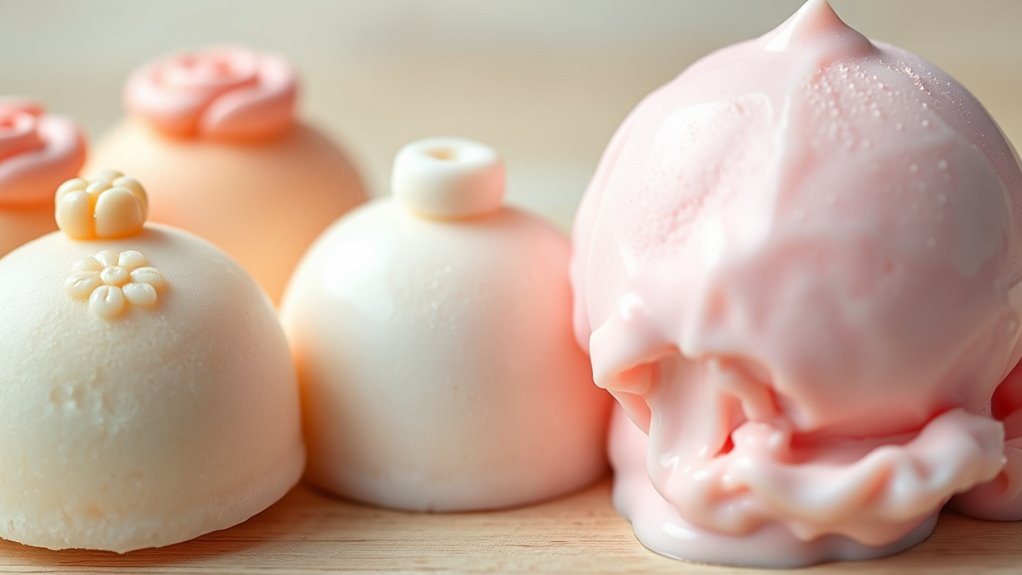Mochi has transformed from traditional Japanese wagashi, symbolizing luck and community, into a versatile treat enjoyed worldwide. Initially made by kneading and pounding rice, modern techniques now include innovative flavors like matcha, fruit, and chocolate. The creation of mochi ice cream combined chewy rice with creamy ice cream, boosting its global popularity. If you want to explore how tradition blends with modernity, there’s much more to discover behind mochi’s fascinating evolution.
Key Takeaways
- Mochi originated over 1,000 years ago in Japan as a traditional wagashi symbolizing good fortune and community.
- Traditional mochi is made through steaming or pounding glutinous rice, emphasizing craftsmanship and cultural preservation.
- Modern innovations introduced flavors, fillings, and production techniques, expanding mochi’s culinary versatility and global appeal.
- Mochi ice cream combines chewy mochi with creamy ice cream, marking a significant evolution in presentation and popularity.
- Balancing tradition with innovation remains vital to preserve mochi’s cultural authenticity amid modern adaptations.
The Origins and Cultural Significance of Traditional Mochi
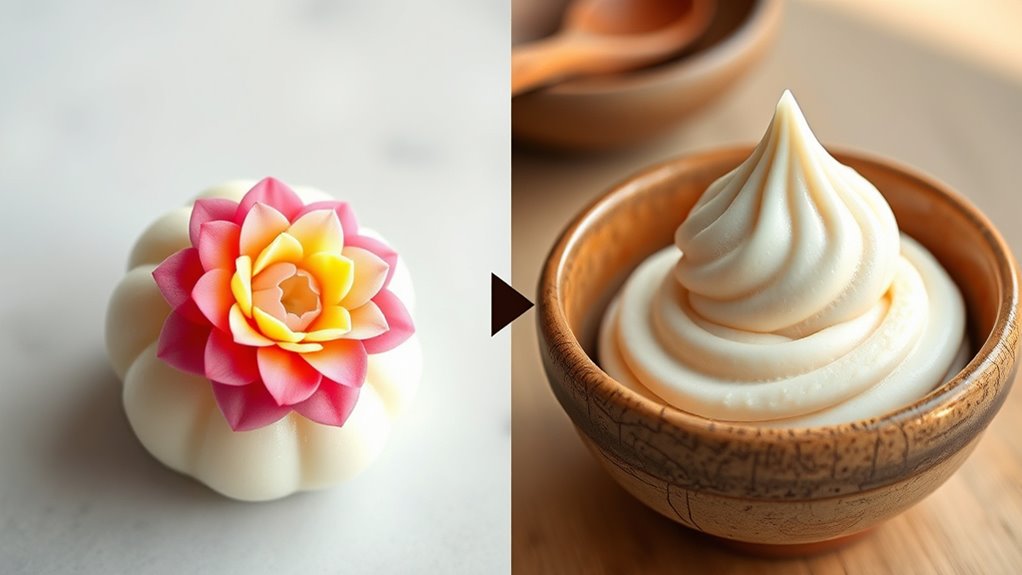
Traditional mochi has deep roots in Japanese history, dating back over a thousand years. You might not realize it, but this sticky rice cake plays an essential role in celebrations and rituals. During New Year’s, you’ll often see mochi as a symbol of good fortune and longevity, representing community and prosperity. Historically, making mochi was a communal activity, bringing people together to knead and pound rice. It’s more than just food—it’s a cultural artifact that embodies resilience and tradition. Mochi’s significance extends beyond festivals; it’s a way to honor ancestors and mark important life events. By sharing mochi, you participate in a centuries-old tradition that connects you to Japan’s rich cultural heritage. Additionally, traditional methods often involve meticulous craftsmanship, highlighting the skill and dedication of those who produce it. This craftsmanship is preserved through traditional techniques, which have been passed down through generations. The artistic influence of mochi-making reflects its importance not only as nourishment but also as a form of cultural expression and community bonding. In modern times, innovative variations like mochi ice cream have emerged, blending tradition with contemporary tastes while maintaining cultural significance. Furthermore, the enduring cultural significance of mochi often depends on cultural continuity, ensuring that these traditions are kept alive for future generations.
Techniques and Ingredients in Crafting Wagashi Mochi
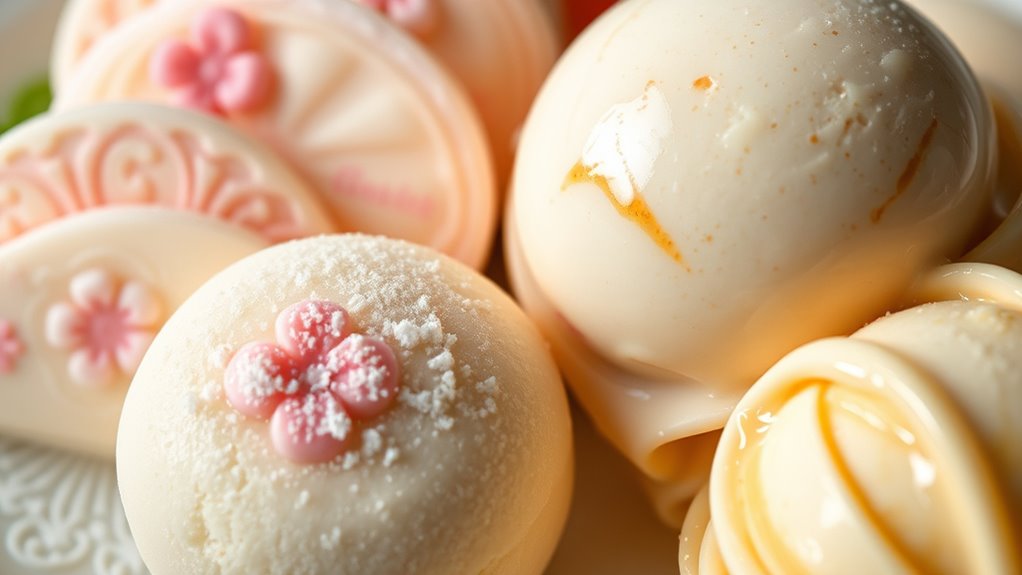
Crafting wagashi mochi involves a careful selection of ingredients and precise techniques that set it apart from everyday mochi. You start with high-quality glutinous rice or mochiko flour, ensuring a soft, chewy texture. The dough is then steamed or kneaded thoroughly to achieve the right consistency. To enhance flavor and appearance, you incorporate ingredients like red bean paste, chestnuts, or matcha. Precision is key when shaping and filling the mochi, often involving delicate handwork. Key techniques include:
Crafting wagashi mochi involves careful ingredient selection, steaming, kneading, and delicate shaping for authentic flavor.
- Steaming or pounding rice to create smooth, elastic dough
- Proper kneading to develop the ideal texture
- Filling with sweetened bean paste or fruit
- Dusting with cornstarch or rice flour to prevent sticking
- Mastering self-sufficiency through traditional methods enhances the ability to produce high-quality mochi at home
These methods and ingredients combine to produce the elegant, flavorful wagashi mochi that’s cherished in Japanese tradition.
The Rise of Modern Mochi Flavors and Variations
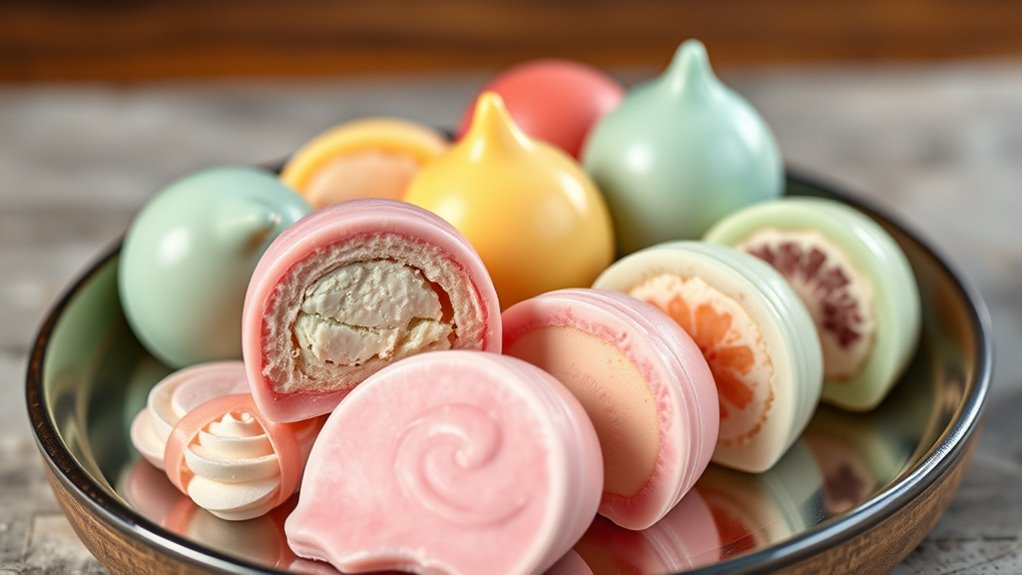
Have you noticed how modern mochi flavors are transforming the classic treat into a playground of innovative tastes? Today’s mochi isn’t just filled with traditional red bean paste; it features an array of exciting options like matcha, mango, strawberry, and even chocolate. Chefs and food creators experiment with unique ingredients, blending cultural influences and seasonal produce to craft new variations. You’ll find mochi infused with coffee, lavender, or yuzu, appealing to diverse palates. This evolution reflects a desire to keep mochi fresh and relevant while honoring its roots. The process of product innovation and exploring new flavors allows for a more mindful approach to culinary innovation. Incorporating food trends and customer preferences into mochi development helps ensure its continued popularity. This ongoing culinary evolution demonstrates how traditional foods can adapt to contemporary tastes. The use of ingredient customization in mochi creation enables chefs to cater to diverse dietary needs and preferences. With such creative twists, mochi now appeals to a broader audience, offering a delightful mix of familiar textures and unexpected flavors. Modern mochi truly celebrates innovation while respecting tradition.
Introduction of Mochi Ice Cream and Its Global Popularity
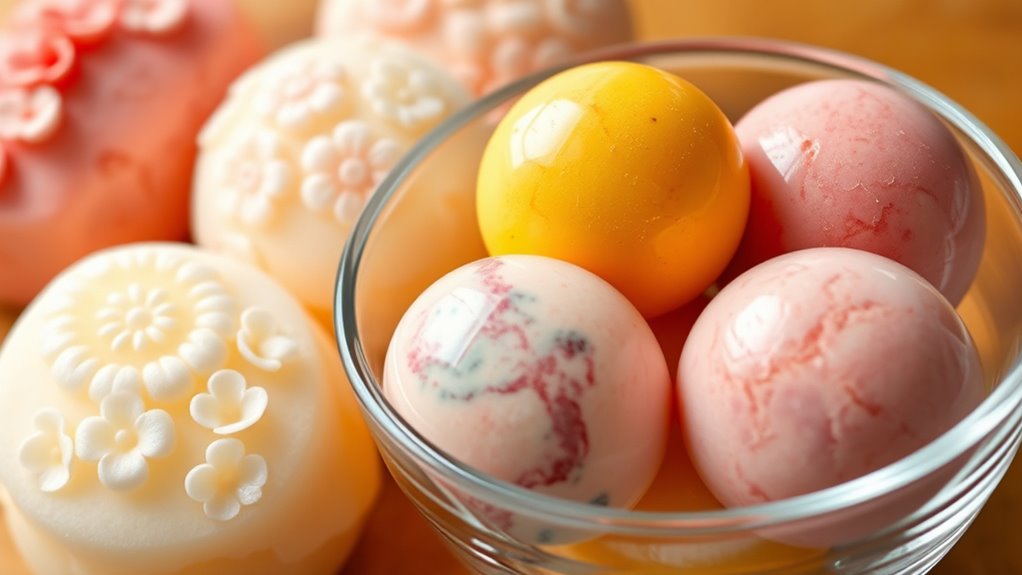
Mochi ice cream has rapidly gained popularity worldwide, transforming the way you enjoy this classic treat. Its unique combination of chewy mochi and creamy ice cream offers a delightful contrast in textures. This fusion has made it a favorite across many countries, from the United States to Europe. You’ll find it in grocery stores, specialty shops, and even high-end restaurants. Its appeal lies in its portability and variety of flavors, appealing to diverse tastes. Additionally, the vibrant colors and wide color gamut of mochi ice cream enhance its visual appeal, making it even more enticing to consumers. Incorporating data-driven marketing strategies can further boost its global presence and consumer engagement.
The Impact of Culinary Innovation on Mochi’s Tradition
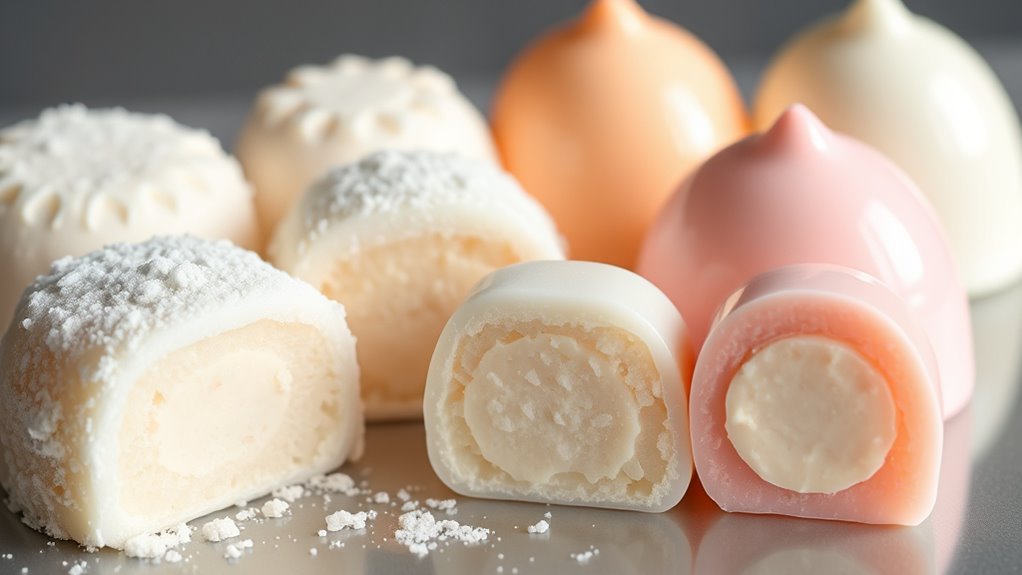
Culinary innovation has transformed mochi by introducing new flavors and modern production methods, making it more accessible worldwide. These changes spark a conversation about whether tradition stays intact or gets overshadowed. You’ll want to contemplate how these innovations impact cultural preservation and the authenticity of mochi. Additionally, the incorporation of natural elements and mindful presentation can help maintain a connection to its cultural roots amidst modern adaptations. Understanding the ethical considerations involved in food innovation can also guide responsible culinary development. Furthermore, integrating AI-powered techniques into traditional food production can enhance quality control and customization, ensuring that authenticity is preserved while embracing innovation. Emphasizing leadership skills in culinary innovation can foster responsible development and ensure that traditions are respected during modernization.
Fusion of Flavors
How has the infusion of new flavors transformed traditional mochi? It’s opened up endless possibilities, blending classic ingredients with unexpected tastes. Today, you’ll find mochi filled with everything from strawberries to matcha, red bean to mango, creating exciting new combinations. This flavor fusion attracts a broader audience and keeps the tradition fresh. Incorporating visual and auditory cues can also inspire creative presentation and tasting experiences that enhance appreciation of these innovations. Some ways this innovation impacts mochi include:
- Introducing exotic fruits for vibrant, fresh flavors
- Combining traditional fillings with modern twists, like chocolate or cheese
- Using natural ingredients to enhance authenticity
- Encouraging experimentation with seasonal and limited-edition varieties
Additionally, integrating sensory elements such as texture and aroma can elevate the overall tasting experience, making traditional mochi more engaging for modern consumers. Furthermore, the use of cultural preservation as a metaphorical concept highlights how blending innovation with tradition can lead to a more dynamic and appealing product, much like how patches enhance skincare routines by targeting specific concerns without replacing essential steps. This evolution doesn’t replace tradition; it enhances it, allowing mochi to adapt to modern palates while honoring its roots. Embracing culinary innovation ensures that traditional mochi remains relevant and exciting for future generations.
Modern Production Techniques
Innovations in production techniques have revolutionized how mochi is made, allowing for greater consistency, efficiency, and creativity. Modern machinery automates kneading and pounding, ensuring uniform texture and reducing manual labor. Freeze-drying and vacuum packaging extend shelf life, making mochi more accessible worldwide. You can now produce larger quantities quickly, maintaining quality standards. New techniques also enable innovative flavors and fillings, expanding traditional boundaries. Microwave and steam technologies streamline preparation, making mochi easier to enjoy at home. Additionally, food-grade preservatives and stabilization methods improve safety and freshness without compromising taste. These advancements have transformed mochi from a handcrafted craft into a versatile, mass-produced treat—yet, they also raise questions about balancing tradition with innovation. Furthermore, the adoption of food preservation techniques helps prolong freshness and safety, ensuring product integrity during distribution and storage. The integration of modern manufacturing methods has significantly enhanced production capabilities and quality control. By leveraging technological advancements, producers can meet increased demand while maintaining high standards. Overall, modern techniques continue to shape mochi’s evolution in exciting, impactful ways.
Cultural Preservation Challenges
As modern production techniques make mochi more accessible and varied, they also introduce challenges to preserving its traditional essence. You might find innovative flavors and shapes, but these changes risk diluting the cultural significance of mochi. Traditional methods, like hand-pounding and specific ingredient choices, often get overshadowed by mass production. This shift can lead to a loss of authenticity and cultural identity.
To preserve tradition, consider these factors:
- Balancing innovation with authenticity
- Educating consumers on mochi’s cultural roots
- Supporting artisanal and local producers
- Maintaining traditional techniques amid mass production
Navigating these challenges requires conscious effort to honor mochi’s history while embracing modern tastes.
Future Trends in Mochi’s Evolution and Global Appeal
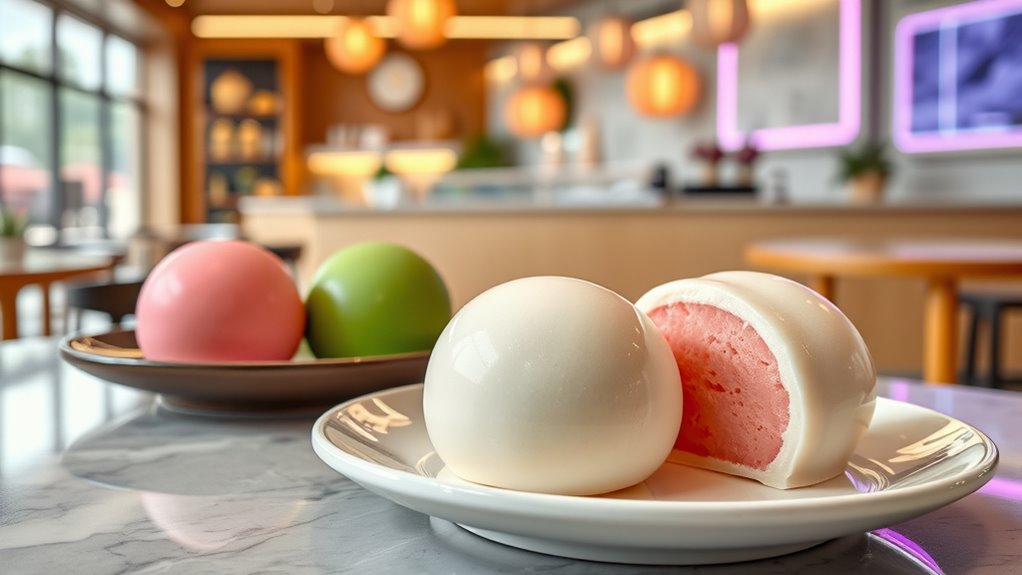
Looking ahead, the future of mochi’s evolution and its global appeal promises exciting opportunities driven by innovative flavors, healthier ingredients, and creative presentation methods. You’ll see chefs experiment with unique fillings like fruit purees, matcha, or even savory options to attract diverse tastes. Health-conscious consumers will favor mochi made with organic, low-sugar, or gluten-free ingredients, expanding its reach. Additionally, innovative presentation techniques—such as mini bites, layered designs, or incorporating mochi into desserts like parfaits—will make it more visually appealing and shareable on social media. As mochi gains popularity worldwide, expect collaborations with local cuisines and fusion creations that blend traditions with modern trends. Collectively, these developments will solidify mochi’s status as a versatile, globally loved treat.
Frequently Asked Questions
How Did Mochi Originally Become a New Year Tradition in Japan?
You might wonder how mochi became a New Year tradition in Japan. Traditionally, people believed that mochi could bring good luck and ward off evil spirits. During the New Year, families gather to make and eat mochi, symbolizing prosperity and longevity. This custom dates back centuries and is deeply rooted in Japanese culture, emphasizing renewal, gratitude, and hopes for a prosperous year ahead.
What Are Some Lesser-Known Regional Variations of Traditional Mochi?
Imagine discovering hidden treasures in Japan’s diverse regions. You’d find fascinating mochi variations like the Hokkaido-style with sweet red bean filling, or the Kyoto-style wrapped in kinako powder. In Nagoya, they make mochi with chestnut paste, and in Okinawa, coconut-flavored mochi delights locals. Each regional twist showcases unique ingredients and techniques, making mochi more than just a treat—it’s a cultural mosaic waiting for you to explore.
How Do Modern Chefs Incorporate Mochi Into Contemporary Desserts?
You can see modern chefs getting creative with mochi by blending traditional techniques with new flavors and presentation styles. They incorporate mochi into contemporary desserts like mochi ice cream, using innovative fillings and textures, or stacking it in layered parfaits. Some add unexpected ingredients like matcha, fruit, or even savory elements. This fusion keeps mochi exciting, appealing to new audiences while honoring its cultural roots.
Are There Health Concerns Associated With Eating Mochi Regularly?
You might wonder if eating mochi regularly poses health risks. While mochi is delicious, it’s high in calories and carbs, which could impact your blood sugar and weight. That said, moderation is key. If you have diabetes or allergies, be cautious with ingredients like sweeteners or additives. Enjoy mochi as an occasional treat, and balance it with a healthy diet to avoid potential health concerns.
What Innovations Might Influence Mochi’s Future Culinary Applications?
Imagine the future of mochi—what surprises lie ahead? You might see innovations like plant-based fillings, healthier sweeteners, or even savory versions that redefine its role in cuisine. Advances in food technology could make mochi more versatile, appealing to diverse tastes. As chefs experiment, you’ll witness mochi transforming from traditional treat to innovative culinary creation, blending tradition with modern innovation to surprise your palate.
Conclusion
While some might think mochi has lost its traditional charm with all the modern flavors and ice cream varieties, it actually showcases its incredible versatility. By blending age-old techniques with innovative twists, mochi stays relevant and exciting worldwide. Embrace these changes, and you’ll see that tradition and innovation can coexist beautifully. So, don’t worry—mochi’s rich history continues to evolve, inviting everyone to enjoy its timeless appeal in new and delicious ways.
